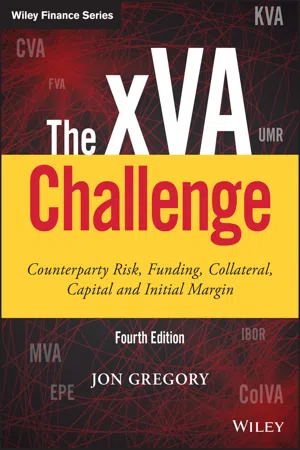
The xVA Challenge
Counterparty Risk, Funding, Collateral, Capital and Initial Margin
- English
- ePUB (mobile friendly)
- Available on iOS & Android
About This Book
A thoroughly updated and expanded edition of the xVA challenge
The period since the global financial crisis has seen a major re-appraisal of derivatives valuation, generally expressed in the form of valuation adjustments ('xVAs'). The quantification of xVA is now seen as fundamental to derivatives pricing and valuation. The xVA topic has been complicated and further broadened by accounting standards and regulation. All users of derivatives need to have a good understanding of the implications of xVA. The pricing and valuation of the different xVA terms has become a much studied topic and many aspects are in constant debate both in industry and academia.
- Discussing counterparty credit risk in detail, including the many risk mitigants, and how this leads to the different xVA terms
- Explains why banks have undertaken a dramatic reappraisal of the assumptions they make when pricing, valuing and managing derivatives
- Covers what the industry generally means by xVA and how it is used by banks, financial institutions and end-users of derivatives
- Explains all of the underlying regulatory capital (e.g. SA-CCR, SA-CVA) and liquidity requirements (NSFR and LCR) and their impact on xVA
- Underscores why banks have realised the significant impact that funding costs, collateral effects and capital charges have on valuation
- Explains how the evolution of accounting standards to cover CVA, DVA, FVA and potentially other valuation adjustments
- Explains all of the valuation adjustments – CVA, DVA, FVA, ColVA, MVA and KVA – in detail and how they fit together
- Covers quantification of xVA terms by discussing modelling and implementation aspects.
Taking into account the nature of the underlying market dynamics and new regulatory environment, this book brings readers up to speed on the latest developments on the topic.
Frequently asked questions
Section 1
Basics
1
Introduction
2
Derivatives
2.1 INTRODUCTION
- Interest rate risk. They need to manage liabilities such as transforming floating- into fixed-rate debt via an interest rate swap.
- Foreign exchange (FX) risk. Due to being paid in various currencies, there is a need to hedge cash inflow in these currencies, for example, using FX forwards.
- Commodity risk. The need to lock in commodity prices either due to consumption (e.g. airline fuel costs) or production (e.g. a mining company) via commodity futures or swaps.
Table of contents
- Cover
- Table of Contents
- List of Spreadsheets
- List of Appendices
- Acknowledgements
- About the Author
- Section 1: Basics
- Section 2: Risk Mitigation
- Section 3: Building Blocks
- Section 4: The xVAs
- Glossary
- References
- Index
- End User License Agreement